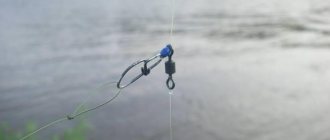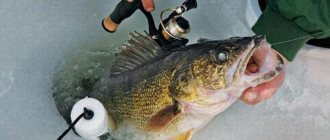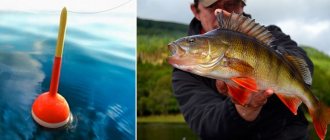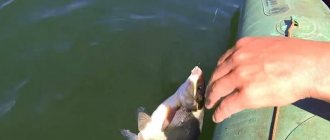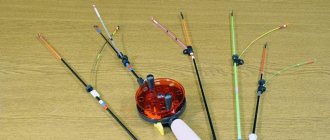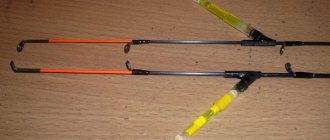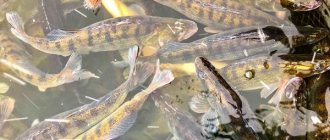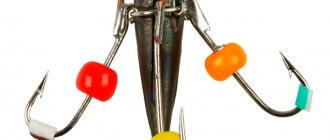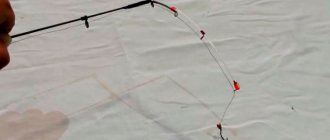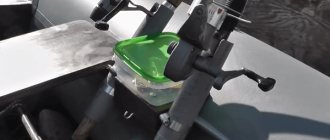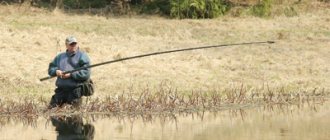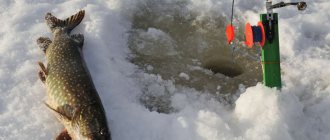Fishing Rods Review
05 February
Review of winter fishing rods for trolling
Winter fishing is a favorite pastime of many people. Fishing with a spoon is extremely exciting and allows you to catch predators such as:
- pike;
- big perch;
- crucian carp;
- bream;
- pike perch.
Fishing with lures in winter is a virtuoso art that requires knowledge, skills, endurance and perseverance. Its success depends not only on strategy, but also on the choice of gear, which differ in characteristics and equipment. What could they be?
Types of winter fishing rods for trolling
Winter fishing rods for trolling are divided into two groups:
1. Light nodding tackle, working with small vertical spoons, balancers, and silicone fish. They are designed for catching perch, roach, chub, are equipped with nods, and can be supplemented with reels if fishing takes place in places with differences in depth. The models have short fishing rods that allow you to throw baits to the desired height and instantly hook fish. They have a guard that signals bites.
2. Powerful noddle-free forms. They are designed for catching large pike and pike perch at great depths using a fishing line with heavy spoons, large balancers, soft baits, and rattlins. The models have a rigid, powerful whip and high-sensitivity carbon tips that act as a guard. These are plug-in or telescopic gear that provide strong hooking and active play of the bait and are equipped with reliable reels.
Design and technical characteristics
The design of winter spinners includes:
1. Ergonomic short handles made of cork, wood, foam. Neoprene handles are not available in winter versions, as they freeze in the cold.
2. Whip. Its length and degree of rigidity depends on what kind of fish is being hunted. If it is a small perch or roach, soft short whips are used; if it is a pike or pike perch, hard, elongated whips are used.
3. Nod. Its presence is necessary when using light baits or during the period of passivity of a large predator. At such times, perch often bites at the moment when the spoon sinks to the bottom. Without a nod, the fisherman will not notice the bite and will not have time to strike the fish, which will quickly spit out the spoon.
4. Coil. It is used when catching large trophies at changes in depth. Inertia-free and multiplier models with a trouble-free clutch and spools ranging in size from 2000 to 3000 are suitable, allowing you to quickly fish out large trophies. When fishing for small and medium-sized fish, they do without reels. The line is simply wound around the handle.
The gear has the following technical characteristics:
— length from 20 centimeters to 75 centimeters;
— power low, medium, high;
- test from 15 grams to 65 grams.
For mormyshing with a nozzle
If fishing with a jig will be carried out using a nozzle, you need to make a more massive rod. Use foam, wood or cork to make the handle.
It is necessary to give the product the appearance of a staple, often called a “filly” by fishermen. You need to make a groove in the workpiece in which the fishing line is wound.
«>
«>
The fact that now you can’t see spinners in fishing stores that are positioned as specialized pike spinners is “a lie and a provocation” that diverts the pike fisher’s interest to the popular balancers. Yes, of course, balance beams are excellent baits, but the vertical bait is not a perfect bait either. Moreover, in fact, there are plenty of vertical models on sale that are well suited for pike fishing.
The most important point: the actual play of the spinner and the play of the spinner that the fisherman achieves are completely different things. The coolest bait is not able to catch fish unless a skilled hand is applied to it, i.e. it depends on the skill of a particular fisherman whether the bait will arouse keen interest in the predatory fish or whether it will not pay attention to it, then you will not get a bite.
Explosive move
Experienced spinners have developed original ways of sparkling, different from the endless mass of banal options. One of the options for trolling perch is considered especially effective, the features of which are as follows.
As the fishing horizon increases, the weakening of the sensation of the force of the push suggests that it is time to use a heavier bait, more suitable for the given depth.
Chasing pike
The fact that now you can’t see spinners in fishing stores that are positioned as specialized pike spinners is “a lie and a provocation” that diverts the pike fisher’s interest to the popular balancers. Yes, of course, balance beams are excellent baits, but the vertical bait is not a perfect bait either. Moreover, in fact, there are plenty of vertical models on sale that are well suited for pike fishing.
Correct swings are the basis for success
If we are talking about the swing of a pike-perch spoon, then it is recommended that it be even softer than when hunting for pike. Often this cannot even be called a wave; rather, it is a leisurely rise, in the initial phase of which zander bites occur. The so-called vertical zander spoons, slightly curved at the tail, with a high swing are capable of moving a considerable distance away from the hole - the same feature of the bait is often used in deep hunting for large perch - humpback fish.
Tips for fisherman: How to tie a leash to a winter fishing rod - What to choose for fishing
Pause
Skilled fishermen suggest clearly separating the concepts: a pause when playing with a vertical line and a pause in the game of bait itself.
When fishing for pike, the lion's share of bites are recorded a little earlier - at the most inert phase. Most pike perch are hooked either during the phase of a smooth rise of the bait, or on an already stationary spoon during a moment of a prolonged pause.
Benefits of hanging tee
On many lakes and reservoirs, winter anglers note the fairly high efficiency of perch spinners (including small ones) equipped with a suspended tee, rather than a soldered single or double hook. Moreover, a vertical with a suspended tee is characterized by increased catchability, regardless of what is on it (fly, cambrics, beads), and even if it is completely “bare.”
Light tackle
Winter fishing rods for trolling perch, pike and pike-perch - Which video to choose? Winter fishing rods for trolling perch, pike and pike-perch - Which one to choose? You can watch the video from the Shcherbakov brothers “The Devil’s Dozen” online in good quality on our website. Enjoy watching!
Winter fishing rods for trolling perch, pike and pike-perch - Which video to choose? Winter fishing rods for trolling perch, pike and pike-perch - Which one to choose? You can watch the video from the Shcherbakov brothers “The Devil’s Dozen” online in good quality on our website. Enjoy watching!
In this issue of “The Devil's Dozen,” the Shcherbakov brothers will answer in detail 13 of the most asked and interesting questions related to winter fishing rods for trolling perch, pike and pike perch in winter.
When using massive lures, it is fluorocarbon that is needed, not monofilament.
Features of equipment for winter fishing rods
The design of winter models for trolling does not play as big a role as their equipment. She is the one responsible for a successful catch. Equipment options depend on the fishing method.
1. Stationary fishing. In this case, the nozzle stands motionless in the water column or at the bottom, bites are transmitted using a nod. The equipment is selected according to the degree of its elasticity so that the fish cannot feel their weight and swallow the bait without fear. These can be light jigs attached to a thin fishing line. It is important that they provide synchronous play with the nod.
- 2. Fishing in the current. In this case, special weighted equipment is used that can be held in the water flow and remain very sensitive. They necessarily contain lead leads and heavy sinkers, which can be replaced with a feeder set assembled using inline technology.
Techniques for fishing with winter lures or winter lures for perch
The trolling technique involves periodically swinging the fishing rod with pauses. First you need to lower the spoon into the hole to the very bottom. Then raise it to a height of about 5–10 cm above the bottom, this will become the starting point. This is followed by a swing of the fishing rod to a height of 15–30 cm, then the spoon is immediately lowered to its initial position and a pause is maintained for two to five seconds or more. Then swing again, etc.
The success of fishing largely depends on finding fish. Perch is a schooling fish; if you catch one in the same hole, you can catch it until the school moves away. But when you find perches, the main thing is not to hesitate. A school of perch does not stay in one place for a long time. After catching the next specimen, you need to remove it from the hook as quickly as possible and lower the spoon under the ice to the level where the trophy was caught. It should be noted that the striped predator has peaks of biting and periods of calm, regardless of whether it is the first/last ice or deep winter.
Tips for a fisherman: How to catch a jig with bloodworms in winter - Detailed review
The size of the spoon is very important. It often happens when, when fishing with a fairly large spoon, a perch only sluggishly “knocks” on it, but does not dare to swallow it. In this case, replacing larger spinners with smaller ones, 2 cm long, helps. It is advisable not to use pike anti-bite leashes, swivels, or fasteners during periods of weak bite (also in the dead of winter). All this once again alarms the cautious fish. Even the excessive shine of the spinner can discourage the striped fish from eating.
Now we hold the bait on the bottom for a couple of seconds and then make a light swing with the rod. Usually a perch that has bitten goes after the spoon to pick it up from the bottom. And at the moment of the swing, the striped one is spotted on the outside in the area of the chin. If we had made the hook at the moment of the “poke”, then the perch most likely would not have been detected. He rarely gets caught when he is not in the mood to take the lure with his mouth. But the striped fish picks up the bait that has fallen to the bottom. Perhaps the perch’s instinct kicks in that the prey it has hit must be taken before it wakes up.
If things get really bad with the lure, they switch to jig fishing. Most likely, the perch needs a very small bait and at the moment it feeds exclusively on insects (for fishing with a jig, see the link at the very beginning of this article). After trolling, they immediately try to fish in the hole with a jig. That is, it turns out that we collect a school with the help of a spinner, and catch it with a jig. That’s why, in addition to a fishing rod for trolling, I also take jig tackle with me.
«>
Equipment according to fish type
The types of equipment depend on the type of production.
1. Roach fishing. To do this, take light fishing rods that work with fishing line with a diameter of 0.06 to 0.1 millimeters, artificial baits, and small jigs.
2. Perch fishing. Forms of medium hardness with removable reels, fishing lines with a diameter of 0.12 to 0.16 millimeters, cone-shaped nods up to 10 centimeters high, brass, silver or copper balancer spinners with a length of 7 to 10 centimeters are used.
3. Pike fishing. It uses high-power fishing rods with whips from 40 to 50 centimeters long, multiplier reels for fluorocarbon fishing line, and braided cord with a diameter of 0.26 to 0.3 millimeters. To prevent the pike from biting them, you need to attach a leash made of Kevlar, guitar string. In this case, you need fish-shaped balancers from 5 to 10 centimeters long, which cling to the leash using swivels equipped with carabiners.
4. Bream fishing. For the equipment you need a small supply of fishing line with a float without a jig, with a hook on which there is edible bait. No additional loading required. In winter, bream does not catch at great depths.
5. Fishing for pike perch. For fishing you will need a powerful fishing rod with a smooth action, monofilament or fluocarbon fishing line with a diameter of 0.25 to 0.35 millimeters. When using artificial baits, you can fish without nodding. Spoons should have an oblong shape and a length of 7 to 10 centimeters.
6. Fishing for crucian carp. Fishing rods are equipped with lavsan nods or thin metal plates replacing them, soft guards with high sensitivity and a length of 15 to 20 centimeters. For fishing you will need a fishing line with a diameter of 1.12 to 0.16 centimeters, a strong and thin hook with a small groove, tungsten jigs of brass, copper, silver, and red.
Examples of equipment for different types of lures
The easiest way to assemble a winter fishing rod for a balancer or spoon is based on specific examples of proven gear. Let's consider working options in light and heavy “weight”.
Photo 4. Heavy spoon assembly.
Equipping a light fishing rod for perch fishing
Winter lure of perch allows you to successfully cast a fishing rod with the following parameters.
- A fishing rod with a cork handle and a soft whip with a total length of 30-35 cm.
- A desirable element would be the presence of a small inertial plastic coil with a diameter of 5 cm.
- It is enough to wind 20-30 m of 0.12-0.20 mm monofilament on the drum. At the beginning of each season, it is better to renew thin monofilament.
- The choice of nod depends on the type and weight of the bait. It is advisable to group the entire arsenal by weight. For each group you can select a sensitive guard made of steel or lavsan plate. Under load, the nod deviation should be within 20-30 degrees from the horizon. In this case, the length of the guard should be limited to 50-60 mm.
- Lures are selected taking into account the fishing location and time of year. Gliding spinners and “studs” have proven themselves to be effective against perch. Perch balancers are considered to be models with a length of 30-40 mm, although a hungry robber can grab larger baits.
Tackle for pike and zander
If you have an old unnecessary spinning rod, it’s enough to simply make a working homemade fishing rod for a heavy balancer or spinner.
- First of all, you need to shorten the handle. The optimal size is 20cm.
- The butt is equipped with a tube into which the whip is mounted. If the spinning tip is too rigid, then you can purchase a carbon fiber tip and equip it with rings. A good option would be a heavy feeder quivertype.
- On a whip 40-50 cm long, it is enough to install 3-4 guide rings. Often the tulip does not match the diameter of the carbon whip. In this case, you can cut off the tip of the fiberglass top with a tulip 30-35 mm long. Then clean the form with sandpaper, apply glue and install the piece inside the main whip. The joint is smoothed by winding the thread and then applying 2 layers of varnish.
- The presence of a reel seat on the handle simplifies the installation of an inertia-free model or meat grinder.
- To catch pike perch or bersh, you can use a 0.16-0.20 mm monofilament line without a leash.
- Among the baits, it is worth noting special zander verticals, balancers and rattlins weighing up to 40 g. This fishing rod can be used not only for balancers, but also for silicone baits.
Modern anglers have a wide selection of fishing rods for winter fishing. You can not only buy good tackle in a store, but also assemble it yourself. It's time to start preparing for the winter season!
